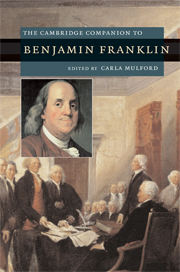Book contents
- Frontmatter
- Introduction
- 1 Benjamin Franklin’s library
- 2 The Art of Virtue
- 3 Franklin’s satiric vein
- 4 Franklin in the republic of letters
- 5 Benjamin Franklin’s natural philosophy
- 6 Franklin and the Enlightenment
- 7 Franklin and the question of religion
- 8 The pragmatist in Franklin
- 9 Franklin on national character and the Great Seal of the United States
- 10 Protestant ethic or conspicuous consumption? Benjamin Franklin and the Gilded Age
- 11 Benjamin Franklin and the American Dream
- 12 Benjamin Franklin’s Autobiography, then and now
- Further reading
- Index
1 - Benjamin Franklin’s library
Published online by Cambridge University Press: 28 January 2009
- Frontmatter
- Introduction
- 1 Benjamin Franklin’s library
- 2 The Art of Virtue
- 3 Franklin’s satiric vein
- 4 Franklin in the republic of letters
- 5 Benjamin Franklin’s natural philosophy
- 6 Franklin and the Enlightenment
- 7 Franklin and the question of religion
- 8 The pragmatist in Franklin
- 9 Franklin on national character and the Great Seal of the United States
- 10 Protestant ethic or conspicuous consumption? Benjamin Franklin and the Gilded Age
- 11 Benjamin Franklin and the American Dream
- 12 Benjamin Franklin’s Autobiography, then and now
- Further reading
- Index
Summary
After Benjamin Franklin settled in Philadelphia and established himself as a printer, he returned to Boston to see his family, demonstrate his success to them, and retrieve his personal collection of books, which he had left behind upon first leaving Boston. The precise contents of Franklin's library at this time in his life is unknown. What is known is that his collection was substantial enough to impress the captain of the sloop that took him back to Philadelphia. When the sloop reached New York, the captain informed William Burnet, the colonial Governor of New York and New Jersey, about this bookish young man. The distinguished, scholarly governor asked to meet him. Franklin described their meeting in his autobiography: “The Governor treated me with great Civility, show'd me his Library, which was a very large one, and we had a good deal of Conversation about Books and Authors” (A, NCE 26).
Beyond what Franklin wrote in his autobiography, no additional comments survive to document their meeting, but the catalogue of Burnet's library provides a good indication of what he and Franklin talked about that day. The Governor was the son of Gilbert Burnet, Bishop of Salisbury. Among the handsomest volumes in his collection were finely bound editions of his father's works. He had an edition of Bishop Burnet's Rights of Princes (1682) bound in morocco, a large paper edition of his three-volume History of the Reformation (1679-1715) bound in red morocco with gilt edges, a large paper edition of his History of His Own Time (1724), and a copy of his Exposition of the Thirty-Nine Articles (1699) formerly in the possession of the Duke of Gloucester. Governor Burnet also had a good collection of belles lettres, science books, and travel writings.
- Type
- Chapter
- Information
- The Cambridge Companion to Benjamin Franklin , pp. 11 - 23Publisher: Cambridge University PressPrint publication year: 2009
- 1
- Cited by

